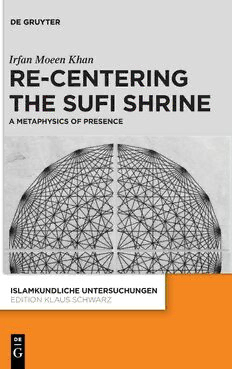Table Of ContentIrfan Moeen Khan
Re-centering the Sufi Shrine
Islamkundliche
Untersuchungen
Band 348
Irfan Moeen Khan
Re-centering
the Sufi Shrine
A Metaphysics of Presence
ISBN 978-3-11-078102-1
e-ISBN (PDF) 978-3-11-078149-6
e-ISBN (EPUB) 978-3-11-078155-7
ISSN 0939-1940
Library of Congress Control Number: 2022945396
Bibliographic information published by the Deutsche Nationalbibliothek
The Deutsche Nationalbibliothek lists this publication in the Deutsche Nationalbibliografie;
detailed bibliographic data are available on the Internet at http://dnb.dnb.de.
© 2023 Walter de Gruyter GmbH, Berlin/Boston
Cover image: Construction Drawing 3, marble sculpture, inlaid (Pietra dura) with granite
© Hamra Abbas
Printing and Binding: CPI books GmbH, Leck
www.degruyter.com
To the memory of my father Muhammad Shafiullah Khan
and mother Anjum Shafiullah
Acknowledgements
IsubmittedthisworkasmyPh.D.dissertationtoTheCommitteeontheStudyof
Religion(GSAS)atHarvardUniversity.Itisaculminationofmyinterestinstudy-
ing religious authority, especially in reference to ritual practice and mysticism.
ThestudyofritualspacesofSufishrinesrequiresthestudyoftextsandanthro-
pologicalfieldwork.Hence,IvisitedseveralSufidargāhsinLahore,Qasur,Mul-
tan, Bahawalpur, Karachi, Faisalabad, Islamabad, and remote villages such as
Fazilpur (in South Punjab) and other lesser-known rural vicinities. During
thesetrips,Imetseveraldervishfigures(menandwomen)whosewarmhospital-
ity and words have been sources of wisdom.
Inthisjourneying,myutmostgratitudeisreservedforManzūrSaīn,anun-
lettered expert on wujūdī philosophy and Persian poetry,who accompanied me
during avisit to the tombs of Khawaja Ghulām Farīd in Kot Mithan on foot (at
times,weusedpublictransport,packedwithpassengers).Duringthesepilgrim-
ages, Manzūr Saīn spoke to me about the Sufi lore of friendship and the meta-
physics of presence. I must also acknowledge that it was incredibly advanta-
geous for me to be the great-grandson of Shaykh Muḥammad Chishtī (Gharīb
Nawāz),whosedargāhisinavillageoutsideofLahore.ItwasatShaykhMuḥam-
mad Chishti’s shrine that a chance encounter in observing a mystic during his
zikr(Ar.Dhikr)onalatewintrynight,andthewordsspokeninastateofecstasy,
left me bewildered, despite my life-long familiarity with Sufi spaces.There was
something verydifferent about the mystic’s voice and the penetrating power of
his words that I cannot explain. So, my question was, how could I write about
what I had witnessed or experienced at the dargah in an academic language?
I do not claim to have solved this problem in this book, but it does address
the importance of understanding the theopoetics of ritual space beyond texts.
Iwasfortunatetohavethefriendshipofseveralpeoplewhosekindnessand
advice helped me at different points of my academic journey. Nabeel Sarwar’s
guidance some twenty-three years ago will never be forgotten. Dr.Jamil Rashid
pointedmetoMcGillUniversityasasuitableplaceformyMAinIslamicStudies
(ProfessorSajidaAlvi’sexpertiseinIslamicintellectualhistoryprovedespecially
useful for my work). Dr.Warnock Davies for showing me the art of the applica-
tion process and sharing his wisdom about what it means to devote a life to
learning during the early stages of my career. I was fortunate to be a TA for
the lateDr. Linda Walbridge of Indiana University,whowas teachingat the La-
horeUniversityofManagementSciences,toworkonherprojectaboutChristian
communitiesinPakistan.LindathoughtIwouldmakeanexcellentanthropolo-
gistandencouragedmetopursuemygraduatestudies.Iamindebtedtothelate
https://doi.org/10.1515/9783110781496-001
VIII Acknowledgements
Dr. Zafar Ishaq Ansari for the incredible affection showered on me when I
showedupathisofficeoneafternoonattheIslamicResearchInstitute,Islama-
bad, after finishing my master’s degree from McGill, looking for potential em-
ployment. I wish I could have seen him one last time after completing my
Ph.D.to offer mygratitude in person.
Dr.WilliamA.Graham(HarvardUniversity)taughtmehowcompassionand
scholarshipcouldcoexist.Eachdraftofthechapterwasreturnedtomewithex-
tensivecommentsandeditsthathelpedmeimprovethework.Iwasfortunateto
havehisguidanceateverystage.Ifanyonewhosepresencewasasourceofcom-
fortduringtherigorsofwriting,itwasDr.KimberleyC.Patton.Thecurrentproj-
ect emerged from a paper presented in her seminar, “Relics,Tombs, and Tran-
scendence.” I learned about the merits of comparative inquiry in religion from
her.Thanks to Dr. Ali S. Asani for his insights into Sufism and the piping hot
cups of tea at his office in the Barker Center. I also want to mention scholars
whohavecontributedtomylearningatHarvardUniversity:Dr.DavidLamberth
(I still have his copy of John McDermott’s monograph), Dr. Francis X.Clooney,
Dr.StepheniePaulsell,Dr.DavídCarrasco,Dr.SteveCaton,Dr.ArthurKleinman,
Dr.ParimalPatil,Dr.RobRobson,Dr.LuisManuelGirón-Negrón,andthelateDr.
Shahab Ahmad.
ThankstoKatharinaZülhkeattheDeGruyterPress,whoseexperthelpmade
theprocessoffinalizingthemanuscriptgosowell.Anyshortcomingsaresolely
myresponsibility.Finally,Ioweamountainofthankstomylovelywife,Hamra
Abbas,forherincrediblesupportandpatience.Theartworkonthecover(collec-
tionofMr.TaimurHassan)isbyher,entitledConstructionDrawing.Mytwoboys
ShaafKhanandValiKhan,havebroughtlightintoourlivesthathas(atleastin
myopinion) made me a better scholar.
Contents
Introduction 1
Chapter One
A Case of Ritual Incongruity in the Practice of Ziyāra: Ḥāẓirī and Fātiḥa 17
. Ḥāẓirī 19
. Fātiḥā (du‘ā) 29
. A Barelwī Defense of Ziyāra: ‘Allamā Ṭahir al-Qādirī 37
Chapter Two
Study of Sufism and Ritual 45
. “Discourse” and Ritual Experience 48
. Mystical Body 50
. Sufism and Textual Islam 54
. The Textual Biases of Recent Scholarship on Sufism 69
. Ineffability and Authority: The Unsayable 72
Chapter Three
Ritual and the Politics of Sufism: Governing the Tombs 76
. The Politics of Scripture: The Ṭarīqa-i Muḥammadīyya in India 80
. Nationalization of Sufi Shrines in Pakistan 99
. Pakistan (Nation-State) and Islam 107
. Sovereignty and Scripture in Pakistan 112
. The Body and Islamic Reform 113
. Ambiguity and Ritual 115
Chapter Four
Ritual and Bulleh Shāh 122
. Hagiography and Ritual: “Thaiyā Thaiyā” 127
. Religious Identity of Bulleh Shāh 133
. ‘Ishq 141
. Metaphysics of Presence 150
Chapter Five
Festival Ritual 161
. Melā in Indus Sufism 165
. Melā in Kāfī Verse 167
. ‘Urs as Festival (Celebration) 186
X Contents
Chapter Six
Ḥāẓirī and the Ritual ofSam ā‘ 192
. Scripture and Sufi Poetry 196
. Theopoetics of Nisbat 203
. Samā‘ at the Dargāh 207
. On Ecstasy (ḥāl and wajd) 209
Conclusion 216
Bibliography 220
Sourcesin Arabic, Persian, Urdu, and Punjabi 220
Sourcesin English 221
Index 239

